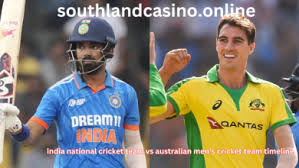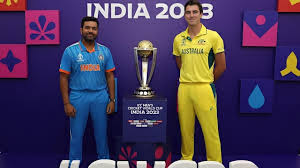india national cricket team vs australian men’s cricket team timeline Cricket is more than just a sport in India and Australia—it’s a passion that unites millions. When the Indian national cricket team and the Australian men’s cricket team face-off, the entire cricketing world watches with bated breath. This rivalry has grown over the decades, and today it is one of the most intense and celebrated matchups in international cricket. From early encounters to modern-day classics, this article delves deep into the timeline of India vs. Australia cricket, examining key moments, matches, and the evolving relationship between the two cricketing giants.
- The Beginning of a Legendary Rivalry (1932-1960s)
The India-Australia cricket rivalry officially began in the 1947-48 season when India embarked on their first-ever tour of Australia. However, the seeds of this rivalry were sown decades earlier with the rise of international cricket in both countries.
The Early Tours

India’s debut in international cricket came in 1932 against England, while Australia had already established itself as a formidable force in the game. Although both nations shared the cricketing culture passed down from the British, their encounters were rare until the mid-20th century. Australia, boasting legends like Sir Don Bradman, was a dominant force. India’s entry into Test cricket began with matches against England, and it took some time before they could take on Australia regularly.
India’s First Tour of Australia
The 1947-48 tour was India’s first visit to Australian shores. It was a tough initiation for the Indian team, who faced a dominant Australian side led by Don Bradman, widely regarded as one of the greatest batsmen ever. Australia won the series 4-0, but it was the beginning of something special between the two countries.
Gradual Growth in the 1950s and 60s
During the 1950s and 60s, encounters between India and Australia were still infrequent. Test matches between these two teams were played, but there was no great sense of rivalry yet. Australia continued to dominate, but India showed glimpses of their potential. The rivalry would soon intensify with the evolution of cricket and a new generation of players.
- The 1970s: Sunil Gavaskar and Dennis Lillee Set the Stage
The 1970s marked a significant shift in the India-Australia rivalry. This was an era where both teams started building legacies, and certain players played a huge role in developing the rivalry into what we know today.
Sunil Gavaskar’s Arrival
Sunil Gavaskar’s rise as one of India’s finest batsmen gave the Indian team a sense of belief that they could compete with the best. His technique, especially against fast bowlers, was exemplary, and it wasn’t long before he made a name for himself on Australian soil. In the 1977-78 series in Australia, Gavaskar stood tall despite India losing the series 3-2. His performances against the likes of Dennis Lillee and Jeff Thomson, two of the fastest bowlers in the world, were a hallmark of resilience.
Dennis Lillee vs. India
On the Australian side, Dennis Lillee became a key figure in the rivalry. Known for his aggressive bowling and competitive spirit, Lillee’s battles with Indian batsmen became legendary. The duel between Gavaskar and Lillee was a fascinating subplot in the broader rivalry. The 1977-78 series is often remembered for the fierce competition between these two greats, showcasing the emerging intensity between the teams.
The Birth of ODI Cricket
The 1970s also saw the birth of One-Day International (ODI) cricket, and India and Australia were among the early adopters. The new format provided more frequent opportunities for the two nations to face off. However, it was still Test cricket that fueled the main rivalry during this decade, and both teams continued to grow in stature.
- The 1980s: India Finds Its Footing
The 1980s were a transformative period for Indian cricket. The team began to assert itself on the international stage, and its encounters with Australia became more competitive. India’s performances improved significantly, and the rivalry began to heat up.
Kapil Dev’s Influence
Kapil Dev emerged as one of India’s greatest all-rounders during this period. His contributions with both bat and ball were crucial to India’s success, and he played a pivotal role in India’s famous 2-0 series win over Australia at home in 1979-80. This series victory was a turning point for India, as it gave them the confidence to challenge Australia more fiercely.
The 1985 World Championship of Cricket
One of the most significant moments in the India-Australia rivalry during the 1980s was India’s triumph in the 1985 World Championship of Cricket held in Australia. India, led by Sunil Gavaskar, shocked the cricketing world by winning the tournament. This victory on Australian soil was a major boost for Indian cricket and a sign that the team could perform under pressure against strong opponents like Australia.
The 1986 Tied Test
Perhaps the most iconic moment of the 1980s between these two teams was the 1986 Tied Test in Chennai (then Madras). This match is only the second-tied Test in cricket history, and it remains one of the most thrilling encounters between India and Australia. Both teams played out a nail-biting contest that ended with the scores level, marking a rare and dramatic outcome. This match solidified the rivalry and set the stage for even greater battles in the years to come.
- The 1990s: Rise of Modern Greats and Increased Competitiveness
The 1990s saw a golden era for cricket, and the India-Australia rivalry reached new heights. This was the era of legends like Sachin Tendulkar, Shane Warne, and Steve Waugh, who took the competition between the two sides to another level.
Sachin Tendulkar’s Brilliance
Sachin Tendulkar’s rise to superstardom coincided with India’s growing stature in world cricket. He made his debut against Australia in 1991, and it wasn’t long before he was tormenting Australian bowlers with his sublime batting. His century at the Sydney Cricket Ground (SCG) in 1992, when he was just 19, is still remembered as one of his finest knocks. Over the next decade, Tendulkar would go on to dominate Australian bowling attacks, making him one of the most feared batsmen in the world.
The 1996 Titan Cup
Another important event in the India-Australia rivalry during the 1990s was the 1996 Titan Cup. This triangular ODI tournament, which also featured South Africa, saw India and Australia face off in a series of closely contested matches. India, under the leadership of Mohammad Azharuddin, managed to clinch the trophy, further asserting their dominance in limited-overs cricket.
The Shane Warne Saga
On the Australian side, Shane Warne became one of the most iconic figures in the rivalry. The legendary leg-spinner had many famous battles with Indian batsmen, particularly Tendulkar. Warne’s first tour of India in 1998 is remembered for the way Tendulkar dismantled his bowling in a famous Test series, which India won 2-1. This series is often referred to as the “Tendulkar vs. Warne” showdown and is one of the most memorable chapters in the rivalry.
- The 2000s: Dominance, Drama, and Unforgettable Battles
The 2000s were undoubtedly the most intense period in the history of the India-Australia rivalry. The two teams were now among the top sides in the world, and their encounters were filled with drama, controversy, and unforgettable cricket.
The 2001 Border-Gavaskar Trophy
The 2001 Border-Gavaskar Trophy series is often regarded as one of the greatest Test series of all time. Australia, under the leadership of Steve Waugh, arrived in India with a world-record 16 consecutive Test wins. After winning the first Test, Australia looked set to extend their winning streak. However, India mounted an incredible comeback in the second Test in Kolkata. VVS Laxman’s monumental 281 and Rahul Dravid’s 180 helped India overturn a huge first-innings deficit and win the Test. India went on to win the series 2-1, ending Australia’s streak and marking a historic moment in the rivalry.
India’s Tour of Australia 2003-04
The 2003-04 Test series in Australia was another classic encounter. India, led by Sourav Ganguly, managed to draw the series 1-1, with memorable performances from players like Tendulkar, Dravid, and Laxman. This series is often remembered for India’s resilience, as they managed to match Australia’s firepower in their backyard.
The 2008 “Monkeygate” Controversy
The 2007-08 Test series in Australia was one of the most controversial in the history of the rivalry. The Sydney Test, in particular, was marred by allegations of poor umpiring, sledding, and a racism row involving Indian spinner Harbhajan Singh and Australian all-rounder Andrew Symonds. The incident, later dubbed “Monkeygate,” led to a breakdown in relations between the two teams, but they eventually moved past it. Despite the controversy, the series was fiercely contested, with Australia winning 2-1.
india national cricket team vs australian men’s cricket team timeline
